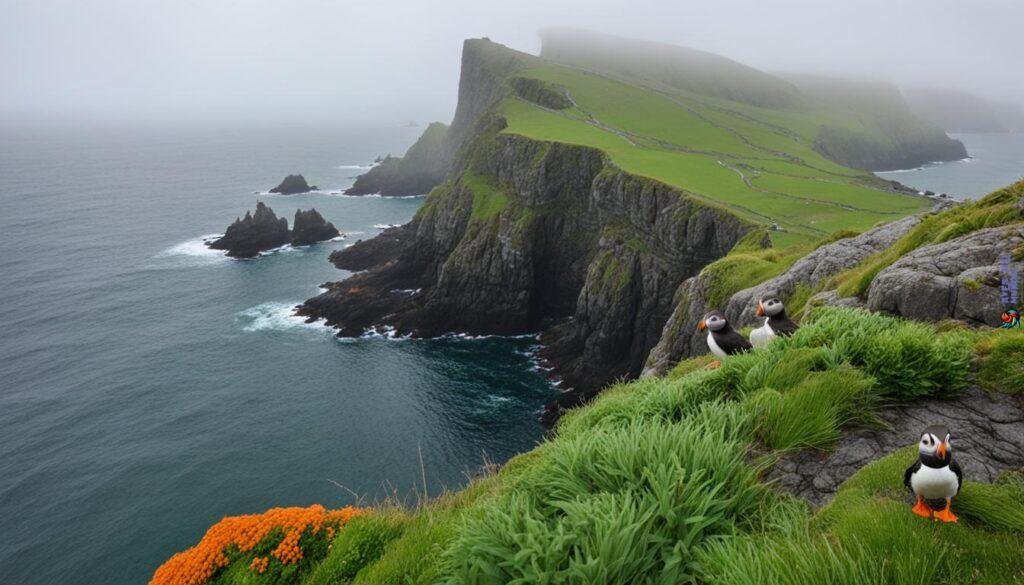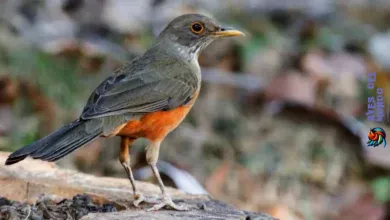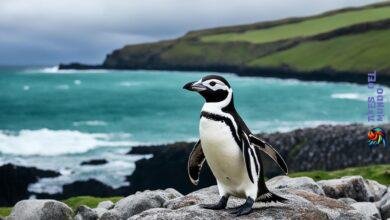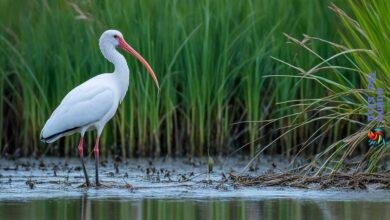If you think you know everything about seabirds, get ready to be surprised by this fascinating fact: Did you know that the population of Atlantic puffins, also known as Fratercula, has experienced a significant decline in recent years?
These adorable puffin birds have captured the hearts of nature enthusiasts with their unique characteristics and behaviors. From their black and white feathers to their large parrot-like beaks, puffins are truly a wonder of the avian world.
But why are these captivating birds facing a decline? How do they live and thrive in their habitat? And what can we do to protect and conserve these beloved creatures?
In this article, we will uncover the secrets of puffins, exploring their habitat, diet, breeding habits, flight and swimming abilities, as well as the conservation efforts needed to ensure their survival in the wild. Get ready to dive into the enchanting world of puffins and discover why these sea parrots are truly a treasure of the Atlantic.
Nicknamed «Sea Parrots»: The Unique Appearance of Puffins
Puffins, also known as Atlantic puffins, are often affectionately nicknamed «sea parrots» or «clowns of the sea» due to their distinctive and charming looks. With their black and white feathers, these adorable seabirds have a striking appearance that provides them with excellent camouflage in the water.
One of the most distinctive features of puffins is their large parrot-like beak, which is perfectly adapted for catching fish. This unique beak is not only functional but also visually appealing, adding to the charm and character of these endearing sea birds.
What makes puffins even more intriguing is that their beak undergoes a color transformation throughout the year. In the winter, the beak takes on a dull grey shade, while in the spring, it transitions to a vibrant orange hue. This change in color is thought to play a role in attracting potential mates during the breeding season.
While puffins come in various species, Atlantic puffins, in particular, stand out for their unique appearance and captivating looks. Their black and white feathers, combined with their parrot-like beak, make them truly one-of-a-kind.
Puffin Appearance at a Glance:
| Feature | Description |
|---|---|
| Feathers | Black and white coloration for effective camouflage in water. |
| Beak | Large and parrot-like, perfectly adapted for catching fish. |
| Beak Color | Dull grey in winter, vibrant orange in spring. |
Puffins truly live up to their reputation as the «sea parrots» or «clowns of the sea» with their distinctive features and endearing personalities.
Life at Sea: The Habitat and Behavior of Puffins
Puffins are remarkable seabirds that spend the majority of their lives at sea, only returning to land during the breeding season. They can be found along the eastern coast of Canada, the United States, and the western coast of Europe, making the North Atlantic Ocean their preferred range. These seabirds are well-adapted to the marine environment and exhibit fascinating behaviors.
When not swimming, puffins rest on the waves, utilizing their webbed feet as a rudder to navigate underwater. They are skilled divers, capable of descending to depths of up to 60 meters in pursuit of their preferred fish. This remarkable diving ability allows them to access food sources inaccessible to other seabirds.
Puffins can be observed in colonies on coasts and islands during the breeding season, creating a mesmerizing spectacle for bird enthusiasts. These colonies serve as breeding grounds where puffins find mates, dig burrows, and nurture their offspring. The presence of these seabirds in large numbers showcases the abundance of marine life in these regions.
«Puffins are truly fascinating creatures with their unique adaptation for life at sea. Their diving capabilities and range make them skilful and agile in their underwater habitat.»
Puffin Habitat and Range
Puffins prefer to make their homes in rocky cliffs, grassy banks, or crevices on coastal islands. These nesting sites provide shelter and protection for their offspring. The North Atlantic Ocean serves as their expansive range, covering various regions along the coastlines of North America and Europe.
Puffin Diving and Swimming Abilities
Puffins showcase remarkable diving and swimming abilities that enable them to thrive in their marine habitat. With their streamlined bodies and powerful wings, they effortlessly dive into the water in search of prey. Their webbed feet serve as efficient propellers, allowing them to navigate underwater with precision and agility. Whether swimming or diving, puffins are truly captivating to observe.
| Puffin Habitat Facts | Puffin Behavior Facts |
|---|---|
| Puffins prefer rocky and grassy nesting sites on coastal islands. | Puffins showcase remarkable diving and swimming abilities. |
| Their preferred range includes the eastern coast of Canada, the United States, and the western coast of Europe. | Puffins rest on the waves and use their webbed feet as a rudder. |
| Puffins are well-adapted to the marine environment. | They can dive up to 60 meters in search of prey. |
Immerse yourself in the captivating world of puffins as they navigate the vast North Atlantic Ocean. Witness their remarkable diving and swimming abilities, showcasing their adaptability to life at sea.
Breeding Habits and Family Life of Puffins
Puffins, like many other seabirds, gather in colonies during the spring and summer months for breeding. These charismatic birds typically form monogamous pairs, with some couples staying together for up to 20 years.
To create their nesting sites, puffins use their sharp claws and beaks to dig burrows in grassy banks or rocky crevices. These burrows provide a safe and protected space for them to lay their eggs and raise their young. The nests are lined with feathers and grass, creating a cozy environment for the growing puffin family.
The female puffin lays a single egg, which both parents take turns incubating for an average of 36-45 days. This shared responsibility ensures the egg receives the warmth and care it needs for proper development. Once the egg hatches, the baby puffin, known as a «puffling,» enters the world.
Puffins are attentive and doting parents. They provide constant care and nourishment to their chicks, ensuring their growth and well-being. Both parents take turns foraging for food, primarily small fish, to feed their hungry offspring. It’s an exhausting but rewarding task for these dedicated seabirds.
As the pufflings grow, their parents gradually introduce them to the water, teaching them essential swimming and diving skills. The parents continue to care for their chicks until they are old enough and strong enough to fend for themselves.

«Puffins are devoted parents, committed to raising their chicks in a safe and nurturing environment.»
Diet and Feeding Habits of Puffins
Puffins are fascinating carnivorous birds with a unique diet and feeding habits. As skilled hunters in the marine environment, puffins rely on a steady supply of small fish for sustenance. Their diet primarily consists of species such as herring, hake, and sand eels.
To catch their prey, puffins employ a diving technique. They dive from the water’s surface and skillfully use their beaks to snatch the fish. Puffins have the remarkable ability to carry multiple fish in their bills, allowing them to bring back food to their nests for themselves and their chicks.
Their specialized beaks are designed for efficient and precise fish-catching. The beaks are serrated, resembling the shape of a pair of scissors, which aids in grip and control while capturing their slippery prey.
«Puffins are agile hunters, effortlessly diving into the water to catch their favorite small fish,» says marine biologist Dr. Sarah Johnson. «Their beaks and diving abilities make them formidable predators in the marine ecosystem.»
Image: Puffins engaging in their natural feeding behavior. (Image Credit: Shutterstock)
Puffins’ diet and feeding habits play a crucial role in their overall survival and the survival of their offspring. The availability of prey, especially small fish like herring, hake, and sand eels, is essential for sustaining the puffin population.
The ability of puffins to catch fish efficiently and provide for their young showcases their remarkable adaptability and intelligence. It is a testament to their well-developed senses and their specialization as carnivorous marine birds.
Flight and Swimming Abilities of Puffins
Puffins are truly remarkable creatures, not only excelling in flight but also displaying impressive swimming skills. These unique seabirds have evolved to adapt to both the sky and the sea, making them versatile and agile in their natural habitat.
When it comes to flying, puffins are true masters of the air. With their strong wings, they are capable of flapping up to 400 times per minute, enabling them to reach impressive speeds of up to 88km/h. Their efficient wing flapping technique allows them to maneuver gracefully through the sky, making them a fascinating sight to behold.
But the wonders of puffins don’t stop at flying. They are equally skilled swimmers, thanks to their webbed feet. Acting as a rudder, their webbed feet enable them to navigate underwater with precision. Puffins can dive to significant depths, reaching up to 60m in search of their favorite fish.
«Puffins are not only excellent flyers but also proficient swimmers, showcasing their remarkable adaptability in both the air and water.»
With their combined flight and swimming abilities, puffins are able to cover extensive ranges, exploring the vast oceans and coastlines where they reside. This adaptability allows them to thrive in different marine environments and seek out abundant food sources for sustenance.
As you can see, puffins are a true marvel of nature, defying expectations with their exceptional flight and swimming skills. Their ability to navigate both the skies and the sea is a testament to their remarkable adaptability and survival strategies.
| Flight Abilities of Puffins | Swimming Abilities of Puffins |
|---|---|
| Puffins flap their wings up to 400 times per minute | Puffins use their webbed feet as a rudder for navigation |
| Puffins can achieve speeds of up to 88km/h | Puffins can dive to depths of up to 60m |
| Puffins are highly maneuverable in the air | Puffins navigate underwater with precision |
Puffin Hot Spots: Where to See These Charming Seabirds
If you’re eager to see puffins in person, there are several hot spots where you can observe these charming seabirds. Puffin colonies can be found on the coasts and islands of the North Atlantic Ocean during the breeding season, which typically occurs between March and July.
Some popular puffin hot spots in the UK and Ireland include St Kilda, Isle of May National Nature Reserve, Skomer Island, and the Cliffs of Moher. These locations offer opportunities to witness the power and beauty of puffins in their natural habitats.

| Location | Description |
|---|---|
| St Kilda | Protected UNESCO World Heritage Site known for its large puffin colonies. The remote and uninhabited islands provide an ideal breeding ground for puffins. |
| Isle of May National Nature Reserve | This nature reserve is home to thousands of puffins and offers visitors the opportunity to see puffins up close on guided tours. |
| Skomer Island | A stunning island off the coast of Wales that hosts one of the largest puffin colonies in the UK. Visitors can explore the island and observe puffins in their natural habitat. |
| Cliffs of Moher | Located on the west coast of Ireland, the Cliffs of Moher provide breathtaking views and are home to a significant puffin population. |
Puffin Conservation: Protecting These Beloved Birds
While puffins are not classified as endangered species, their populations in certain areas are facing decline. The main threats to puffin populations include overfishing, which disrupts the availability of food sources, and pollution, particularly from oil spills. Oil spills can have devastating effects on puffins, as they not only make the birds sick but also destroy their waterproof feathers, which are vital for their survival in the marine environment. Conservation efforts are crucial to protect these beloved birds and ensure their continued existence for future generations.
Threats to Puffin Populations
«Overfishing and pollution, especially oil spills, pose significant risks to puffin populations.»
Overfishing: A Threat to Puffin Food Sources
Puffins rely on a diet of small fish, such as herring, hake, and sand eels. Overfishing depletes these fish populations, reducing the availability of food for puffins. With less prey to feed on, puffins may struggle to find enough sustenance to survive and reproduce.
Pollution and Oil Spills: Devastating Consequences
Pollution, particularly from oil spills, is another significant threat to puffins. When oil spills occur, the oil coats the birds’ feathers, stripping them of their waterproofing properties. Without waterproof feathers, puffins are unable to stay buoyant in the water and may succumb to hypothermia or drown. Additionally, ingesting oil-contaminated fish can make the birds sick, further endangering their survival.
Conservation Efforts for Puffins
To protect puffins and ensure their continued existence, conservation initiatives are essential. These efforts focus on:
- Implementing sustainable fishing practices to safeguard puffin food sources
- Reducing pollution and preventing oil spills to preserve the marine environment
- Establishing protected areas and sanctuaries for puffin breeding and nesting sites
- Conducting research and monitoring programs to better understand puffin populations and their habitat requirements
The Role of Conservation Organizations
Multiple organizations dedicated to puffin conservation work tirelessly to protect these beloved birds. Examples of such organizations include:
- The Puffin Foundation: A nonprofit organization focused on puffin conservation, habitat restoration, and public education.
- The National Audubon Society: Committed to the protection and conservation of seabirds, including puffins, through research, advocacy, and habitat preservation.
- The RSPB (Royal Society for the Protection of Birds): Known for its extensive work in seabird conservation, including efforts to protect puffin colonies and their habitats.
Through collaborative efforts between conservation organizations, governments, and local communities, meaningful progress can be made in safeguarding puffins and ensuring their long-term survival.
| Threats to Puffin Populations | Conservation Efforts |
|---|---|
|
|
Other Murres, Auklets, and Puffins: Diverse Species in the Seabird Family
Puffins are part of a larger group of seabirds that includes murres and auklets. These diverse species have distinct characteristics, habitats, and behaviors. Exploring the different murres, auklets, and puffins can provide a deeper understanding of the rich diversity of seabirds in our oceans.
The Murres
Murres are seabirds that belong to the Alcidae family, just like puffins. They are primarily found in the northern hemisphere, with species such as the common murre, the pigeon guillemot, and the marbled murrelet. Murres have streamlined bodies and excellent diving abilities, allowing them to plunge into the water in search of prey.
The Auklets
Auklets are small seabirds known for their characteristic facial plumage. Two notable species of auklets are Cassin’s auklet and the rhinoceros auklet. Cassin’s auklet has a distinctive white eye ring, while the rhinoceros auklet has a horn-like protrusion on its beak during the breeding season. Auklets are agile swimmers and divers, often feeding on small fish and marine invertebrates.
The Puffins
Puffins, as mentioned earlier, are unique seabirds with their black and white feathers, parrot-like beaks, and the ability to fly and swim with equal grace. Apart from the Atlantic puffin, other notable puffin species include the horned puffin and the tufted puffin. Each puffin species has its own characteristics and adaptations that allow them to thrive in their specific habitats.
| Species | Characteristics | Habitat | Behavior |
|---|---|---|---|
| Common Murre | Black and white plumage, slender body | Coasts and islands of the northern hemisphere | Excellent diving and swimming abilities |
| Pigeon Guillemot | Black and white plumage, red legs, and feet | Coastal areas in the northern hemisphere | Flies underwater using its wings |
| Marbled Murrelet | Mottled brown plumage, small size | Pacific coastal forests | Nests on tree branches away from the coast |
| Cassin’s Auklet | Small size, dark plumage, white eye ring | Coastal areas of the North Pacific | Forms large breeding colonies |
| Rhinoceros Auklet | Black plumage, distinctive horn-like beak | North Pacific Ocean | Uses burrows for nesting |
| Horned Puffin | Brightly colored beak, white face, black back | Coastal areas of the North Pacific | Nests in crevices and burrows |
| Tufted Puffin | Large colorful beak, white plumage, long head plumes | Northern Pacific Ocean | Builds burrows using its beak and feet |
Each species within the seabird family brings its own unique charm to the diverse ecosystem of our oceans. Their varying characteristics, habitats, and behaviors showcase the remarkable adaptations of these birds to survive and thrive in their marine environments.
Conservation Outlook for Murres, Auklets, and Puffins
Like puffins, other murres, auklets, and puffins also face conservation challenges. The main threats to these captivating seabirds are habitat loss, climate change, and human disturbances.
Habitat loss, primarily driven by coastal development, poses a significant risk to the survival of murres, auklets, and puffins. As their natural habitats shrink, these seabirds face limited nesting and foraging opportunities.
Climate change further exacerbates the conservation outlook for these species. The changing climate disrupts ecosystems, leading to shifts in ocean currents and the availability of prey. This can directly impact the reproductive success and overall population of murres, auklets, and puffins.
To ensure the long-term sustainability of these remarkable seabirds, conservation efforts must focus on preserving and enhancing their habitats, reducing human disturbances, and mitigating the effects of climate change. Collaboration between conservation organizations, governments, and communities is crucial in safeguarding the future of murres, auklets, and puffins and maintaining the rich diversity of our marine ecosystems.



